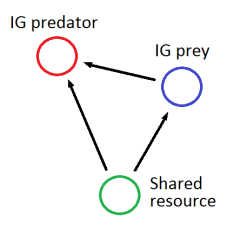Table of Contents
Group 6
Too big to gobble: inducible defences in intraguild predation systems
Wiki site of the practical exercise of the VII Southern-Summer School on Mathematical Biology.
Here you will find the exercise assignment and the group's products.
If you are a group member login to edit this page, create new pages from it, and upload files.
Introduction
When predation risk is high, many prey species employ defence mechanisms that potentially reduce their chances of being consumed. These mechanisms can involve shifts in the morphology, physiology, life-history and/or behaviour of prey species. These so-called inducible defences can have major effects on the dynamics of interacting species.
Kratina et al. (2010) studied the dynamics of an experimental food web consisting of the unicellular algae Rhodomonas minuta which is consumed by both the turbelarian flatworm, Stenostomum virginianum, and hypotrich ciliates of the genus Euplotes spp., while the latter is also eaten by the turbelarian flatworm.
 The presence of predatory flatworms induces a change in morphology of Euplotes, considerably increasing its size. These defended altered forms then have a reduced risk of being eaten by the gape-limited predators. By selecting Euplotes clones with high and low inducibility the authors show that inducible defences enhance persistence of Euplotes in this system.
The presence of predatory flatworms induces a change in morphology of Euplotes, considerably increasing its size. These defended altered forms then have a reduced risk of being eaten by the gape-limited predators. By selecting Euplotes clones with high and low inducibility the authors show that inducible defences enhance persistence of Euplotes in this system.
Figure: Normal and induced morphs of Euplotes octocarinatus. Scale bar is 40 microns. Figure taken from here.
 This system is an instance of one of the basic three-species community modules: intraguild predation. It is composed of two consumers that share a common resource and one of the consumers (the intraguild predator) can prey on its competitor (the intraguild prey) - see figure. One of the challenges of these systems is to find robust conditions for persistence of all three species - they are ubiquitous in nature, but are usually restricted to narrow parameter ranges in models!
This system is an instance of one of the basic three-species community modules: intraguild predation. It is composed of two consumers that share a common resource and one of the consumers (the intraguild predator) can prey on its competitor (the intraguild prey) - see figure. One of the challenges of these systems is to find robust conditions for persistence of all three species - they are ubiquitous in nature, but are usually restricted to narrow parameter ranges in models!
Assignment
Develop and analyze a model for the population dynamics of the system described, taking into account inducible defences of the Euplotes prey, and use it to explore the consequences of this defence mechanism.
Questions and suggestions
- Do inducible defences enhance the persistence of the intraguild prey? What are the conditions or parameter values that allow persistence?
- It is quite reasonable to assume that induced morphs individuals might have a decreased foraging efficiency, as pointed out in Kratina et al (2010). What are the effects of this trade-off in the dynamics?
Challenge
- Inducible defences are not free: they incur extra developmental costs. Assuming a small cost, is it advantageous to have these defences? That is, could it be better to be always small or always big? Under what circumstances?
